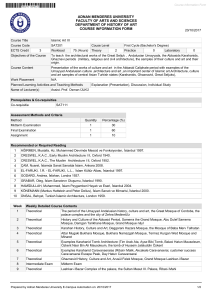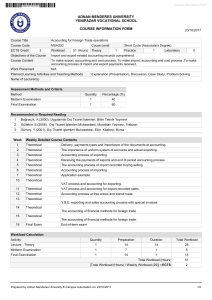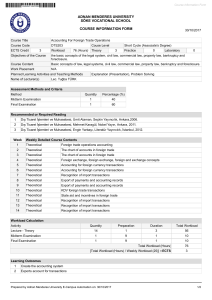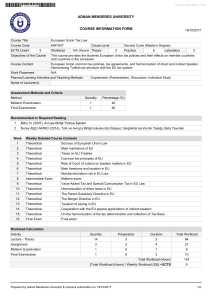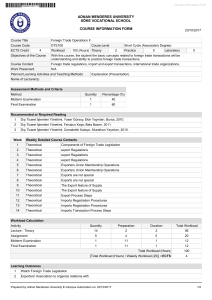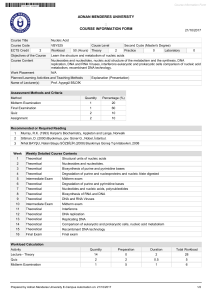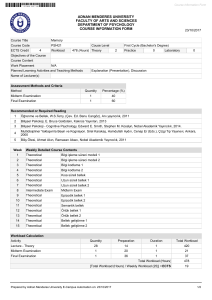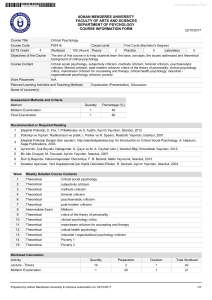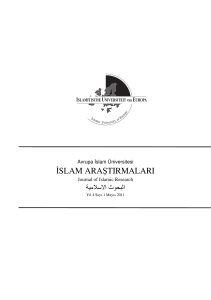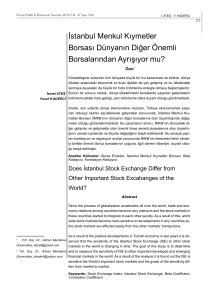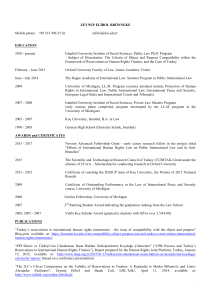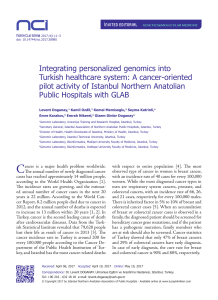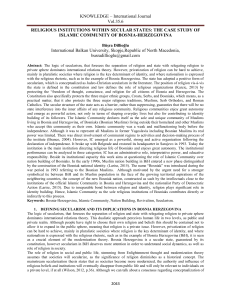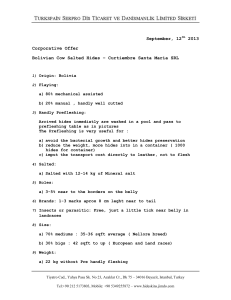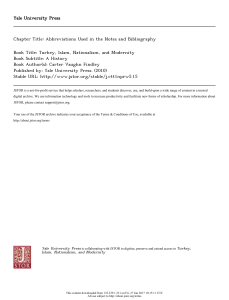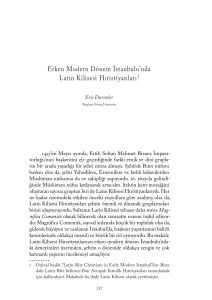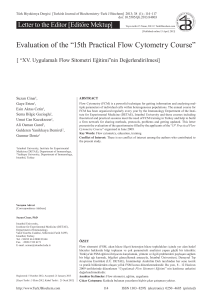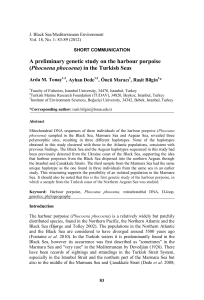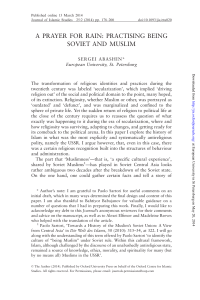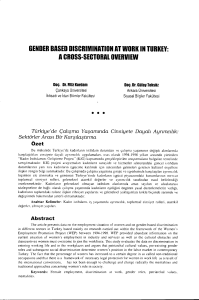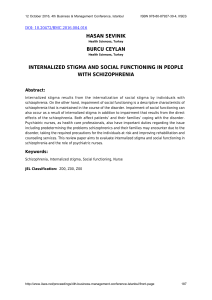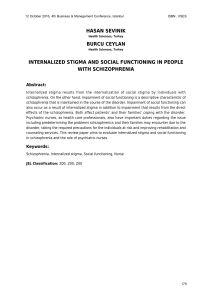adnan menderes university faculty of arts and sciences
advertisement
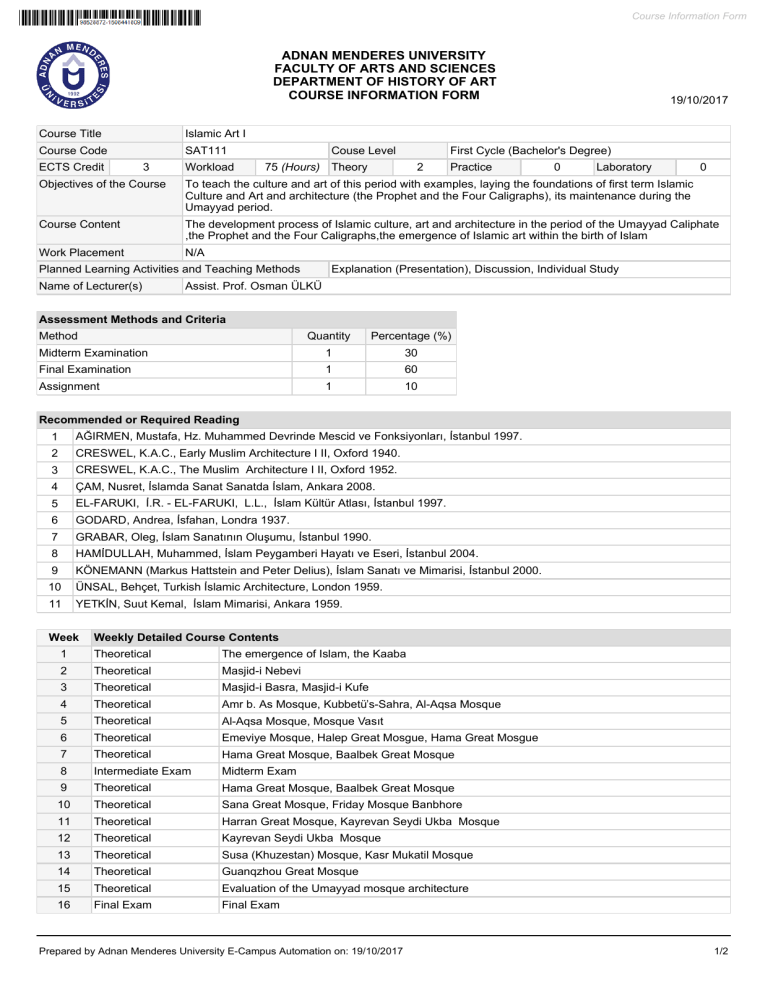
Course Information Form ADNAN MENDERES UNIVERSITY FACULTY OF ARTS AND SCIENCES DEPARTMENT OF HISTORY OF ART COURSE INFORMATION FORM Course Title Islamic Art I Course Code SAT111 ECTS Credit 3 Workload Couse Level 75 (Hours) 19/10/2017 First Cycle (Bachelor's Degree) Theory 2 Practice 0 Laboratory 0 Objectives of the Course To teach the culture and art of this period with examples, laying the foundations of first term Islamic Culture and Art and architecture (the Prophet and the Four Caligraphs), its maintenance during the Umayyad period. Course Content The development process of Islamic culture, art and architecture in the period of the Umayyad Caliphate ,the Prophet and the Four Caligraphs,the emergence of Islamic art within the birth of Islam Work Placement N/A Planned Learning Activities and Teaching Methods Name of Lecturer(s) Explanation (Presentation), Discussion, Individual Study Assist. Prof. Osman ÜLKÜ Assessment Methods and Criteria Method Quantity Percentage (%) Midterm Examination 1 30 Final Examination 1 60 Assignment 1 10 Recommended or Required Reading 1 AĞIRMEN, Mustafa, Hz. Muhammed Devrinde Mescid ve Fonksiyonları, İstanbul 1997. 2 CRESWEL, K.A.C., Early Muslim Architecture I II, Oxford 1940. 3 CRESWEL, K.A.C., The Muslim Architecture I II, Oxford 1952. 4 ÇAM, Nusret, İslamda Sanat Sanatda İslam, Ankara 2008. 5 EL-FARUKI, İ.R. - EL-FARUKI, L.L., İslam Kültür Atlası, İstanbul 1997. 6 GODARD, Andrea, İsfahan, Londra 1937. 7 GRABAR, Oleg, İslam Sanatının Oluşumu, İstanbul 1990. 8 HAMİDULLAH, Muhammed, İslam Peygamberi Hayatı ve Eseri, İstanbul 2004. 9 KÖNEMANN (Markus Hattstein and Peter Delius), İslam Sanatı ve Mimarisi, İstanbul 2000. 10 ÜNSAL, Behçet, Turkish İslamic Architecture, London 1959. 11 YETKİN, Suut Kemal, İslam Mimarisi, Ankara 1959. Week Weekly Detailed Course Contents 1 Theoretical The emergence of Islam, the Kaaba 2 Theoretical Masjid-i Nebevi 3 Theoretical Masjid-i Basra, Masjid-i Kufe 4 Theoretical Amr b. As Mosque, Kubbetü’s-Sahra, Al-Aqsa Mosque 5 Theoretical Al-Aqsa Mosque, Mosque Vasıt 6 Theoretical Emeviye Mosque, Halep Great Mosgue, Hama Great Mosgue 7 Theoretical Hama Great Mosque, Baalbek Great Mosque 8 Intermediate Exam Midterm Exam 9 Theoretical Hama Great Mosque, Baalbek Great Mosque 10 Theoretical Sana Great Mosque, Friday Mosque Banbhore 11 Theoretical Harran Great Mosque, Kayrevan Seydi Ukba Mosque 12 Theoretical Kayrevan Seydi Ukba Mosque 13 Theoretical Susa (Khuzestan) Mosque, Kasr Mukatil Mosque 14 Theoretical Guanqzhou Great Mosque 15 Theoretical Evaluation of the Umayyad mosque architecture 16 Final Exam Final Exam Prepared by Adnan Menderes University E-Campus Automation on: 19/10/2017 1/2 Course Information Form 17 Final Exam Final Exam Workload Calculation Activity Quantity Preparation Duration Total Workload 14 0 2 28 Assignment 1 8 1 9 Reading 10 0 2 20 Midterm Examination 1 7 1 8 Final Examination 1 9 1 10 Lecture - Theory Total Workload (Hours) 75 [Total Workload (Hours) / Weekly Workload (25)] = ECTS 3 Learning Outcomes 1 To be able to comprehend the emergence of Islamic art and the resources affected by outsiders. 2 To be able to make comparison between pre-and post-Islamic cultures. 3 To be able to comprehend the early Islamic mosque architecture. 4 To be able to gain the ability to present the occurrence and spread of Islamic art in a chronological framework Programme Outcomes (History of Art) 1 Acquiring scientific ethic and sense of responsibility. 2 Acquiring ability on data collection, analyzing, interpreting, discussing and proposing about the issues of the History of Art. 3 Having a good level of a foreign language to communicate and to follow up current searches on the History of Art. 4 Gaining objective and consistent interpreting skill via comparing art and architecture products in different geographies. 5 Having ability on semtinizing and evaluating the effects of materials, manufacturing technique, designing, political, social, economical, and ideological factors on production and progress of art and arhictecture products. 6 Acquiring the skill of obtaining and following up the technological progresses and scientific papers in the field of the History of Art. 7 Having ability to practice his/her knowledge on the History of Art in transdisciplinary works. 8 Realizing the meaning and importance of the History of Art in national or international aspects; being capable of evaluation and interpretation of art and architecture products that has survived. 9 Achieving the consciousness of acquising new knowledge and skills lifelong. 10 Having the knowledge of setting up a paralel between the History of World Art and History of Anatolian Art. 11 Having the sensitivity of doing something about art and architecture products, cultural heritage and its environment. 12 Having the ability of written and oral communication and improving the ability to think critically. Contribution of Learning Outcomes to Programme Outcomes 1:Very Low, 2:Low, 3:Medium, 4:High, 5:Very High L1 P2 L2 L4 4 4 3 P4 P5 L3 4 Prepared by Adnan Menderes University E-Campus Automation on: 19/10/2017 2/2
